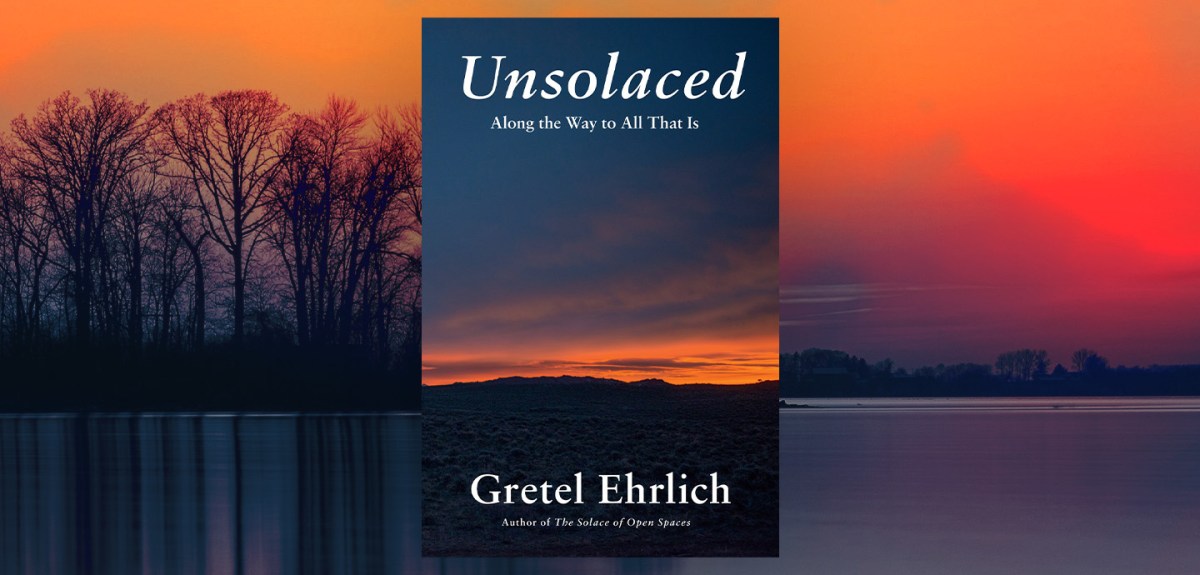[ad_1]
“Home has no walls, no ceiling, nor is its purpose to protect.” So declares Gretel Ehrlich about the moment she identified Wyoming as home in 1975, at age 29, reeling from grief at the loss of her partner and creative collaborator. It’s an authoritative statement and the tone resists contradiction, though it’s not the way most would define home. In Unsolaced: Along the Way to All That Is, she recounts how she settled into a life of cowboying and writing, homesteading through harsh winters and frequent, intense solitude. It’s an existence that suits her until a near-death experience when she’s struck by lightning, followed by a long recovery, divorce, the loss of her ranch and her parents. “In 1993, an unforeseen vitality pushed me back into the world. With no ranch holding me, I plunged: nothing more to lose. Not that I went out seeking excitement; rather, it kept coming to me and I didn’t hesitate to welcome its arrival.”
The book follows some of that excitement, from exploring never-before-tread Arctic fjords, to observing regenerative agriculture projects in the bush of Mugabe’s troubled Zimbabwe. Ehrlich is drawn again and again to places of extreme weather, extreme natural beauty, and extreme interdependence between human, animal, and nature. This is not an intimate psychological memoir; accounts of transformational events like divorce and falling in love are terse. Ehrlich prefers to give voice to the extraordinary people she meets, whether it’s the horsewoman who served as her cowboy mentor, a Kosovar trauma surgeon who gives her a tour of his homeland post genocidal war, or the classical composer/Arctic explorer with a giddy madness for icy landscapes.
The writing is elegant and direct, and the aim is true. Epigrammatic statements like, “climate is culture,” are more than alliterative formulas used at climate summits. They bear the mark of experience, of having spent 20 springs aboard a dogsled with elite hunters and observing the disintegration of their way of life along with the sea ice. Similarly, the reach for the spiritual dimension of human relationships to animals and nature is never empty philosophizing. When Ehrlich writes, “Knowing ‘otherness’ feeds into who we are, and the shared communication binds us,” it’s not an abstraction. It’s a conclusion drawn after being awoken by her herder dog during a full moon and led to observe a herd of elk in a hayfield: “The whole-body sensorium is alive in each of us – dog body, horse body, elk body, human. Sentience is as much about perceiving what others know and are, as it is about examining our own psyches.”
At the same time, her descriptions of the natural world are exacting, and may require a trip to the dictionary to understand the precise image, like this Arctic landscape: “Across a wide valley, alluvial fans aproned out into meltwater deltas chinked with mud the color of deerskin hides. At midnight all but one cloud vanished. The air felt warm and the lake where we camped turned for cerulean to celadon – fine porcelain you could see through as if into the true nature of things.”
Each chapter is self-contained and plunges into a different world. There’s a sense that Ehrlich’s adventures could fill volumes (and indeed, some are explored in depth in her earlier books), but the undertone is not the excitement of discovery but the melancholy of loss. A thread of grief runs through each encounter of human and place. Loss grows to encompass not only beloved people, but animals, places, and entire ways of life. When the source of her solace – great wild places – begins to transform and disappear over the years as the planet warms, the grief becomes sorrow for the natural world itself.
It is through this lens that the disparate international adventures converge into a single narrative. Despite the singularity of Ehrlich’s life and experience, it becomes a story that encompasses every reader as well, a sorrow we all must contend with, even if it’s simply witnessing an early flowering tree in the park or an absence of birdsong. Ehrlich doesn’t offer easy solutions or optimism, but neither does she sink into despair. The response she offers is complex, requiring uniquely human capacities, like innovating ecosystem-based solutions, genuinely understanding that “every blade of grass counts if we are to survive,” and adapting together to an ever-changing sense of place. This last faculty is most effective as a dance: “The choreographer Pina Bausch said, ‘Dance, dance, otherwise we are lost.’ Outside, a ground blizzard swept through. Snow riprapped frigid air, erasing what I knew and all I feared. Shelter in place. I kept coming back to that phrase. In a tsunami, it meant death; in a pandemic, you might survive. But I’d seen how ‘place’ can move on the path of the pronghorn, on the path of ice, and I wanted to move with it.”

NON-FICTION
Unsolaced
By Gretel Ehrlich
Pantheon Books
Published January 5, 2021
[ad_2]
Source link
